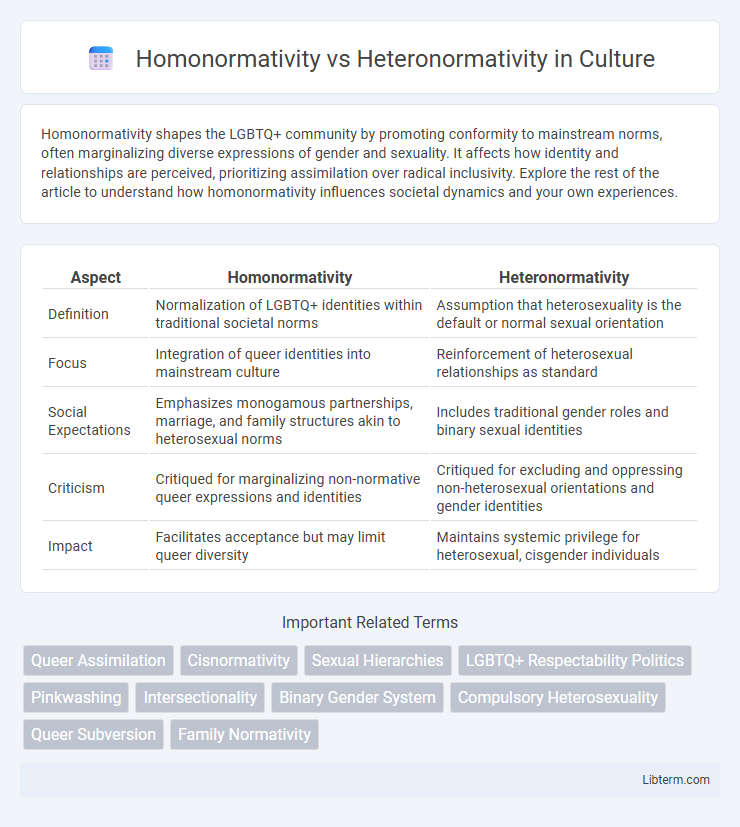Homonormativity shapes the LGBTQ+ community by promoting conformity to mainstream norms, often marginalizing diverse expressions of gender and sexuality. It affects how identity and relationships are perceived, prioritizing assimilation over radical inclusivity. Explore the rest of the article to understand how homonormativity influences societal dynamics and your own experiences.
Table of Comparison
| Aspect | Homonormativity | Heteronormativity |
|---|---|---|
| Definition | Normalization of LGBTQ+ identities within traditional societal norms | Assumption that heterosexuality is the default or normal sexual orientation |
| Focus | Integration of queer identities into mainstream culture | Reinforcement of heterosexual relationships as standard |
| Social Expectations | Emphasizes monogamous partnerships, marriage, and family structures akin to heterosexual norms | Includes traditional gender roles and binary sexual identities |
| Criticism | Critiqued for marginalizing non-normative queer expressions and identities | Critiqued for excluding and oppressing non-heterosexual orientations and gender identities |
| Impact | Facilitates acceptance but may limit queer diversity | Maintains systemic privilege for heterosexual, cisgender individuals |
Understanding Normativity: Defining the Terms
Homonormativity refers to the normalization of same-sex relationships through assimilation into existing heteronormative frameworks, often emphasizing monogamy, marriage, and traditional family roles within LGBTQ+ communities. Heteronormativity is the cultural bias that presumes heterosexuality as the default or normal sexual orientation, structuring societal expectations around binary gender roles and opposite-sex relationships. Understanding normativity involves analyzing how these constructs shape social behaviors, influence identity politics, and affect the inclusion or exclusion of diverse sexual orientations and gender expressions.
Origins and Historical Contexts of Homonormativity and Heteronormativity
Homonormativity emerged in the late 20th century as a critique of homophobia within LGBTQ+ communities, emphasizing assimilation of heteronormative values such as monogamy and marriage equality. Heteronormativity, rooted in historical social structures, assumes heterosexuality as the default sexual orientation and enforces rigid gender roles, reinforcing patriarchal systems since Victorian-era societal norms. The origins of both concepts reflect broader socio-political struggles over identity, rights, and cultural recognition within dominant and marginalized groups.
Key Features of Heteronormativity
Heteronormativity assumes heterosexuality as the default sexual orientation and prescribes traditional gender roles within a binary framework. It privileges opposite-sex relationships, reinforcing societal norms that prioritize marriage, procreation, and nuclear family structures. This paradigm marginalizes non-heterosexual identities and non-conforming gender expressions by positioning them as deviations from an accepted norm.
Characteristics and Impact of Homonormativity
Homonormativity is characterized by the assimilation of LGBTQ+ identities into mainstream heteronormative frameworks, emphasizing conventional family structures, monogamy, and consumerism. This framework often marginalizes more radical queer expressions and reinforces existing social hierarchies by privileging norms aligned with heteronormativity. The impact of homonormativity includes the normalization and increased visibility of LGBTQ+ individuals within society but also the risk of erasing diverse queer experiences and perpetuating exclusion within the community.
Intersectionality: Gender, Race, and Class in Normative Narratives
Homonormativity and heteronormativity both reinforce normative structures that marginalize identities at the intersections of gender, race, and class, perpetuating systemic inequalities. Homonormativity often privileges middle-class, white, cisgender LGBTQ+ narratives, excluding diverse experiences of race and socioeconomic status. Analyzing these paradigms through an intersectional lens reveals how normative narratives sustain power hierarchies and limit inclusive representation across multiple identity dimensions.
Media Representation: Reinforcing or Challenging Normativities
Media representation often reinforces heteronormativity by predominantly depicting heterosexual relationships as the societal standard, marginalizing LGBTQ+ identities through stereotypical or limited portrayals. Homonormativity within media can challenge traditional heteronormativity by normalizing same-sex relationships but may simultaneously uphold normative values such as monogamy and gender conformity, thereby limiting broader queer diversity. Contemporary media that embraces varied narratives and intersectional identities actively deconstructs both heteronormative and homonormative frameworks, promoting inclusivity and redefining societal norms.
The Role of Policy in Upholding or Dismantling Normativity
Policy plays a critical role in either upholding or dismantling homonormativity and heteronormativity by shaping legal recognition, resource allocation, and social norms around sexuality and gender. Laws granting marriage equality or anti-discrimination protections can challenge heteronormative assumptions while sometimes reinforcing homonormative ideals by prioritizing assimilation into existing social structures. Conversely, policies that ignore or criminalize queer identities perpetuate heteronormativity by marginalizing non-heterosexual relationships and reinforcing traditional gender roles.
Queer Theory Perspectives on Homonormativity and Heteronormativity
Queer theory critiques homonormativity for replicating heteronormative structures that privilege assimilation into traditional norms such as monogamy, marriage, and nuclear family models, thereby marginalizing more radical queer identities and expressions. Heteronormativity enforces compulsory heterosexuality and binary gender norms, maintaining societal power imbalances through legal, cultural, and institutional frameworks. Queer theorists argue for destabilizing both paradigms to challenge normative assumptions about sexuality and gender, promoting fluidity and diverse, nonconforming queer existences beyond restrictive binaries.
Social and Psychological Effects on LGBTQ+ Individuals
Homonormativity often reinforces mainstream societal standards within LGBTQ+ communities, leading to exclusion or marginalization of non-conforming identities, which can result in internalized stigma and psychological distress. Heteronormativity perpetuates rigid gender roles and sexual expectations, contributing to minority stress, higher rates of anxiety, depression, and social isolation among LGBTQ+ individuals. Both frameworks impact social inclusion and mental health, highlighting the necessity for intersectional and affirming approaches to support diverse sexual and gender identities.
Moving Toward Inclusivity: Challenging Normative Structures
Homonormativity and heteronormativity both reinforce normative frameworks that marginalize diverse sexual identities, limiting true inclusivity. Challenging these structures requires recognizing the ways homonormativity can replicate exclusionary practices within queer communities while heteronormativity enforces rigid gender and relationship roles. Moving toward inclusivity involves promoting fluid understandings of identity and dismantling systems that prioritize conformity over diversity in sexual and gender expression.
Homonormativity Infographic

 libterm.com
libterm.com